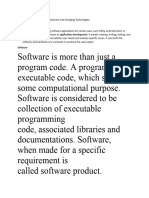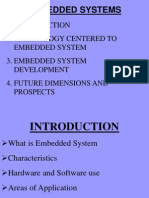Embedded Systems and Inform
Embedded Systems and Inform
Uploaded by
Jerin JoseCopyright:
Available Formats
Embedded Systems and Inform
Embedded Systems and Inform
Uploaded by
Jerin JoseCopyright
Available Formats
Share this document
Did you find this document useful?
Is this content inappropriate?
Copyright:
Available Formats
Embedded Systems and Inform
Embedded Systems and Inform
Uploaded by
Jerin JoseCopyright:
Available Formats
Embedded Systems and Information Appliances
Embedded Systems and Information Appliances
Introduction
Embedded system is a combination of computer hardware, software and, perhaps, additional mechanical parts, designed to perform a specific function. Embedded systems are usually programmed in high level language that is compiled (and/or assembled) into an executable (machine) code. These are loaded into Read Only Memory (ROM) and called firmware, microcode or a microkernel. The microprocessor is 8-bit or 16-bit.The bit size refers to the amount of memory accessed by the processor. There is usually no operating system and perhaps 0.5k of RAM. The functions implemented normally have no priorities. As the need for features increases and/or as the need to establish priorities arises, it becomes more important to have some sort of decision making mechanism be part of the embedded system. The most advanced systems actually have a tiny, streamlined OS running the show, executing on a 32-bit or 64-bit processor. This is called RTOS.
Government Engineering College, Thiruvananthapuram
Embedded Systems and Information Appliances
Embedded Hardware
All embedded system has a microprocessor or microcontroller for processing of information and execution of programs, memory in the form of ROM/RAM for storing embedded software programs and data, and I/O interfaces for external interface. Any additional requirement in an embedded system is dependent on the equipment it is controlling. Very often these systems have a standard serial port, a network interface, I/O interface, or hardware to interact with sensors and activators on the equipment.
Embedded Software
C has become the language of choice for embedded programmers, because it has the benefit of processor independence, which allows the programmer to concentrate on algorithms and applications, rather than on the details of processor architecture. However, many of its advantages apply equally to other high-level languages as well. Perhaps the greatest strength of C is that it gives embedded programmers an extraordinary degree of direct hardware control without sacrificing the benefits of high-level languages. Compilers and cross compilers are also available for almost every processor with C. Any source code written in C or C++ or Assembly language must be converted into an executable image that can be loaded onto a ROM chip. The process of converting the source code representation of your embedded software into an executable image involves three distinct steps, and the system or computer on which these processes are executed is called a host computer. First, each of the source files that make an embedded application must be compiled or assembled into distinct object files. Second, all of the object files that result from the first step must be linked into a final object file called the relocatable program.
Government Engineering College, Thiruvananthapuram
Embedded Systems and Information Appliances
Finally, the physical memory address must be assigned to the relocatable program. The result of the third step is a file that contains an executable image that is ported on the ROM chip. This ROM chip, along with the processor and other devices and interfaces, makes an embedded system run. There are some very basic differences between conventional programming and embedded programming. First, each target platform is unique. Second, there is a difference in the development and debugging of applications.
Government Engineering College, Thiruvananthapuram
Embedded Systems and Information Appliances
Embedded Development Environment
The embedded system may not have a keyboard, a screen, a disk drive and other peripheral devices required for programming and development tasks. Therefore most of the programming for embedded systems is done on a host, which is a computer system with all the programming tools. Only after the program has been written, compiled, assembled and linked is it to move to the target or the system that is shipped to the customers. After writing source file compiling, linking, relocating and porting the executable image into the ROM, you need to test and debug the application. Once you have an executable image stored as a file on the host computer, you need a way to download that image into a memory device on the target board or development board and execute it from there. And if you have the right tools at your disposal, it will be possible to set breakpoints in the program or set break points in the program or observe its execution. These various tools could be a remote debugger, simulator, emulator or an in-circuit emulator. A remote debugger can be used to download, execute, and debug embedded software over the serial port or network connection between the host and the target. In case of embedded systems, the debugger executes on two different computer systems a remote debugger consists of two pieces of software. The front-end runs on the host computer and provides the human interface, and the hidden back-end runs on the target processor and communicates with the front-end over a communication link. The back-end provides low-level control of the target processor and is usually called debug monitor. The debug monitor resides in the ROM and is automatically started whenever the target processor is reset. It monitors the communication link to the host computer and responds to the request from the remote debugger running there. Remote debuggers are the most commonly used tools for downloading and
Government Engineering College, Thiruvananthapuram
Embedded Systems and Information Appliances
testing tools during the development of embedded software mainly because of there low cost. Remote debuggers are helpful in monitoring and controlling the state of embedded software, but only in in-circuit emulators (ICEs) allow you to examine the state of the processor on which that program is running. In fact an ICE actually takes the place of the processor on your target board, or in other words, emulates the work of the processor and provides the human interface with what exactly is happening on the board in real-time. This also allows the ICE to support powerful debugging features such as hardware breakpoints and real-time tracing. Many other debugging tools such as simulators, logic analysers and oscilloscopes are also available in embedded systems. A simulator is a completely host-based program that simulates the functionality and instruction set of the target processor. Although simulators have many disadvantages, they are quite valuable in the early stages of the project when there isnt as yet any actual hardware for the programmers to experiment with. The biggest disadvantage of a simulator is that it simulates only the processor. And embedded systems frequently contain one or more other peripherals. Interaction with these devices can only sometimes be imitated. You may not do much with the simulator once you have the actual embedded hardware available to you. Once the target hardware is available, you can use logic analysers and oscilloscopes as debugging tools. These are very useful for debugging the interactions between the processor and other chips on the board. These tools only view signals that lie outside the processor, and cannot control the flow of execution of your software like debuggers or emulators can. A logic analyser is equipment that is designed to find whether the electrical signal it is attached to is currently to logic level 1 or 0. An oscilloscope so another piece of equipment for hardware debugging, and is used to examine any electrical signal, analogue signal, or digital signal on the hardware.
Application Areas
Government Engineering College, Thiruvananthapuram
5
Embedded Systems and Information Appliances
Embedded software is present in almost every electronic device you use today. There is embedded software inside your watch, cellular phone, automobile, thermostats, industrial control equipment, and scientific and medical equipment. Defence services use it to guide missiles and detect enemy aircrafts. Thus embedded systems cover such a broad range of products that generalization is difficult. Here are some broad categories:Aerospace and defence electronics (ADE): Astronomical research, flight safety and flight management, fire control, robotics, vehicular control. Broadcast and entertainment: analogue and digital sound products, audio control systems, DVD players, digital TV, set-top boxes. Data communication: Analogue modems, ATM broad band switches, cable modems. Digital imaging: Digital still camera, digital video cameras, fax machines, printers, scanners. Industrial measurement and control: Building environmental control systems, industrial sensors, test & measurement devices, traffic management systems. Medical electronics: Cardiovascular devices, critical care systems, diagnostic devices, surgical devices. Server I/O: Embedded servers, LAN devices, supercomputing, server management. Mobile data infrastructures: Mobile data terminals, satellites terminals, wireless LANs, pagers, wireless phones.
Design Requirements
Government Engineering College, Thiruvananthapuram
6
Embedded Systems and Information Appliances
Embedded systems typically have tight constraints on both functionality and implementation. In particular, they have must guarantee real time operation reactive to external events, conform to size and weight limits, budget power and cooling consumption, satisfy safety and reliability requirements, and meet tight cost targets. Real time/reactive operation Real time systems operation means that the correctness of a computation depends, in part, on the time at which it is delivered. In many cases the system design must take into account worst-case performance. Predicting the worst case may be difficult on complicated architectures, leading to overly pessimistic estimates erring on the side of caution. The Signal Processing and Mission Critical example systems have a significant requirement for real time operation in order to meet external I/O and control stability requirements. Reactive computation means that the software executes in response to external events. These events may be periodic, in which case scheduling of events to guarantee performance may be possible. On the other hand, many events may be aperiodic, in which case the maximum event arrival rate must be estimated in order to accommodate worst-case situations. Most embedded systems have a significant reactive component. Small size, low weight Many embedded computers are physically located within some larger artifact. Therefore, their form factor may be dictated by aesthetics, form factors existing in pre-electronic versions, or having to fit into interstices among mechanical components. In transportation and portable systems, weight may be critical for fuel economy or human endurance. Among the examples, the Mission Critical system has much more stringent size and weight requirements than the others because of its use in a flight vehicle, although all examples have restrictions of this type. Safe and reliable Government Engineering College, Thiruvananthapuram
7
Embedded Systems and Information Appliances
Some systems have obvious risks associated with failure. In mission-critical applications such as aircraft flight control, severe personal injury or equipment damage could result from a failure of the embedded computer. Traditionally, such systems have employed multiply-redundant computers or distributed consensus protocols in order to ensure continued operation after an equipment failure However, many embedded systems that could cause personal or property damage cannot tolerate the added cost of redundancy in hardware or processing capacity needed for traditional fault tolerance techniques. This vulnerability is often resolved at the system level as discussed later. Harsh environment Many embedded systems do not operate in a controlled environment. Excessive heat is often a problem, especially in applications involving combustion (e.g., many transportation applications). Additional problems can be caused for embedded computing by a need for protection from vibration, shock, lightning, power supply fluctuations, water, corrosion, fire, and general physical abuse. For example, in the Mission Critical example application the computer must function for a guaranteed, but brief, period of time even under non-survivable fire conditions. Cost sensitivity Even though embedded computers have stringent requirements, cost is almost always an issue (even increasingly for military systems). Although designers of systems large and small may talk about the importance of cost with equal urgency, their sensitivity to cost changes can vary dramatically. A reason for this may be that the effect of computer costs on profitability is more a function of the proportion of cost changes compared to the total system cost, rather than compared to the digital electronics cost alone
Information Appliance
Government Engineering College, Thiruvananthapuram
Embedded Systems and Information Appliances
In the past, embedded systems allowed information appliances to carry out simple and specific functions only. But with the penetration of the Internet into the homes of many ordinary families, it was realized that electric appliances could make human life easier and more convenient if they could access Internet information. Electric appliances can now access the Internet, compute and do what they were not able to do earlier. In other words, electric appliances are being transformed into information appliances (IA) or what may also be called embedded IA. Like the traditional embedded systems, the embedded information appliance needs only the least amount of hardware to operate. It can operate even without a hard disk, or with low power and small footprint. IA product can be classified into four mainstream products: Set-Top Boxes (STB) Personal Access Device (PAD) Thin Client (TC) Residential Gateway (or Home Gateway) Most IA products may be derived, with little or some modifications, from these four types of products.
Set-Top Boxes
The set-top box is driving the digital revolution right into your living room. Your fingertips now command a wealth of high quality digital information and digital entertainment, right from your favorite armchair. The set-top box revolutionizes home entertainment by providing vibrant television images with crystal clear sound, along with e-mail, Web surfing, along with customized information such as stock quotes, weather and traffic updates, on-line shopping, and video-on-demand, right through a traditional television. Government Engineering College, Thiruvananthapuram
9
Embedded Systems and Information Appliances
Personal Access Devices
Personal Access Devices (PADs) are web terminals that feature convenient Web browsing, email, and information access capabilities in a lightweight, mobile form.
Thin Client
A thin client is an information access drive that provides users with remote access to applications and data that are maintained and executed on a central server. The thin-client computing environment consists of an application server, a network, and thin-client devices. By centralizing deployment and updates of corporate applications, thin clients allow for simplified Information Systems (IS) management with dramatically increased security.
Residential Gateway
The RG mainly provides various kinds of interfaces that link all the electronic devices. The RG unlike the PC, is a very small, slim and light piece of hardware and may soon be incorporated inside other popular electronic appliances. It will play the role of an information hub responsible for the exchange of information between all kinds of electronic devices in an ordinary home.
Conclusion
Government Engineering College, Thiruvananthapuram
10
Embedded Systems and Information Appliances
We are standing on the threshold of an exciting new age of information technology that will change our lives and the future forever. Soon we shall see more and more digitization of appliances, and these will be fuelled by human need. Embedded systems and Information Appliances have virtually entered every sphere of our life and they will truly change the way we live.
Government Engineering College, Thiruvananthapuram
11
You might also like
- MCE IMC-SCRRevE8 42027200E PDFDocument449 pagesMCE IMC-SCRRevE8 42027200E PDFken100% (1)
- Embedded SystemsDocument11 pagesEmbedded Systemsapi-3827000No ratings yet
- Embedded Systems and Information AppliancesDocument11 pagesEmbedded Systems and Information Appliancesshaikshaa007100% (4)
- Embedded SystemDocument7 pagesEmbedded SystemSoundarya SvsNo ratings yet
- Embeded PU ComputerDocument188 pagesEmbeded PU ComputerLoknath RegmiNo ratings yet
- Voice Controlled Intelligent Security SystemDocument44 pagesVoice Controlled Intelligent Security SystemSarat ChandraNo ratings yet
- Introduction To Embedded SystemsDocument11 pagesIntroduction To Embedded Systemsramaiah76100% (1)
- Introduction To Embbeded SystemsDocument42 pagesIntroduction To Embbeded SystemsSaikiran ReddyNo ratings yet
- Pravalika MiniDocument72 pagesPravalika Miniramya vattamwarNo ratings yet
- 1505901474lect37 (1Document6 pages1505901474lect37 (1Sharmila DeviNo ratings yet
- 2.1 Embedded SystemsDocument7 pages2.1 Embedded Systemsshyam gamerNo ratings yet
- Basic Organization of A Computer SystemDocument6 pagesBasic Organization of A Computer SystemNadeem AhmedNo ratings yet
- Term Paper On Embedded SystemsDocument7 pagesTerm Paper On Embedded Systemsaflsbbesq100% (1)
- Embedded System NotesDocument66 pagesEmbedded System Notesmu9140615427No ratings yet
- Cte 441Document20 pagesCte 441aulelunenNo ratings yet
- Embedded Systems Tools & PeripheralsDocument4 pagesEmbedded Systems Tools & PeripheralsShoriful Islam TarekNo ratings yet
- Unit Iii General Purpose Processor Software DevelopmentDocument11 pagesUnit Iii General Purpose Processor Software DevelopmentSaritha ReddyNo ratings yet
- CCCCCC CDocument60 pagesCCCCCC CSanthan ManneNo ratings yet
- CPDS Notes Final Unit 1 PDFDocument25 pagesCPDS Notes Final Unit 1 PDFSai TejaNo ratings yet
- Basiccomputer SkillDocument13 pagesBasiccomputer Skillessencehealthcare67No ratings yet
- Embedded Systems: Quiz 2Document19 pagesEmbedded Systems: Quiz 2171148 171148No ratings yet
- Accident Sms Alert SystemDocument105 pagesAccident Sms Alert SystemChandan Kumar SharmaNo ratings yet
- Embedded Systems and MEMS TechnologyDocument16 pagesEmbedded Systems and MEMS Technologyshekar493100% (1)
- Ment NagaDocument73 pagesMent NagaNani NRajNo ratings yet
- Wireless Keyboard & Mouse EmulatorDocument84 pagesWireless Keyboard & Mouse EmulatorVijitha KalassNo ratings yet
- Rush Collision Prevention in Railways Major DocumentDocument77 pagesRush Collision Prevention in Railways Major Document18E3457 MukundiniNo ratings yet
- Unit-2: Embedded Devices-1: Dr. M.S. Pradeep Kumar PatnaikDocument57 pagesUnit-2: Embedded Devices-1: Dr. M.S. Pradeep Kumar PatnaikVamshidhar Reddy0% (1)
- BEI605 Embedded SystemDocument79 pagesBEI605 Embedded SystemKani Mozhi100% (2)
- Face Recognization Based Car Security SystemDocument86 pagesFace Recognization Based Car Security Systemkartheekkumar2812No ratings yet
- Operating System 1.1Document14 pagesOperating System 1.1Partho Pratim SealNo ratings yet
- Unit IDocument37 pagesUnit Idinesaur333No ratings yet
- IT For Business Applications - MBA (MM) - I (DECEMBER 19, 2022)Document87 pagesIT For Business Applications - MBA (MM) - I (DECEMBER 19, 2022)PIYUSH SINGHNo ratings yet
- Embedded Systems Notes - Unit - 3Document11 pagesEmbedded Systems Notes - Unit - 3Ashish AttriNo ratings yet
- Operating SystemDocument81 pagesOperating SystemShabbir AhmadNo ratings yet
- Embedded Systems 2Document8 pagesEmbedded Systems 2Ankit SharmaNo ratings yet
- DepikDocument8 pagesDepikCharak Ram SNo ratings yet
- Overview On Application Development and Emerging TechnologiesDocument5 pagesOverview On Application Development and Emerging TechnologiesKent DivinagraciaNo ratings yet
- Project ReportDocument63 pagesProject ReportEliyasuddin AliNo ratings yet
- Bluetooth Controlled Pick and Place RobotDocument9 pagesBluetooth Controlled Pick and Place RobotVenkatchowdary Mamillapalli100% (2)
- 1 - 627 - Autumn 2019Document18 pages1 - 627 - Autumn 2019Shakeel ManshaNo ratings yet
- Notes ComputerDocument21 pagesNotes ComputerAmit Kumar JhaNo ratings yet
- Computer Assignment 3Document8 pagesComputer Assignment 3Mussawer HasnainNo ratings yet
- Unit 1Document7 pagesUnit 1Jigar DalwadiNo ratings yet
- Virtual MachineDocument16 pagesVirtual Machineapi-19854229No ratings yet
- Embeded SystemsDocument19 pagesEmbeded SystemsParvathi GoudNo ratings yet
- Difference Between Software, Embedded Software and FirmwareDocument2 pagesDifference Between Software, Embedded Software and FirmwarejjjNo ratings yet
- ErtosDocument16 pagesErtosМахеш Бабу100% (1)
- Basics of Operating Systems (IT2019-2) : Assignment IDocument3 pagesBasics of Operating Systems (IT2019-2) : Assignment IGiang LeNo ratings yet
- Embedded SystemsDocument24 pagesEmbedded SystemsDileep KumarNo ratings yet
- Development Process of Embedded SystemsDocument7 pagesDevelopment Process of Embedded SystemsSruthi Reddy100% (1)
- Define Computer-WPS OfficeDocument6 pagesDefine Computer-WPS OfficeUzma AslamNo ratings yet
- Case Motherboard Central Processing Unit Random Access Memory Power Supply Video Card Hard DriveDocument10 pagesCase Motherboard Central Processing Unit Random Access Memory Power Supply Video Card Hard DriveLeighgendary CruzNo ratings yet
- Chapter-1 Introduction To Embedded Systems: CharacteristicsDocument37 pagesChapter-1 Introduction To Embedded Systems: CharacteristicsNelarapuMaheshNo ratings yet
- Statistical Analysis With Software Application: Presented by BSMA 2-4Document68 pagesStatistical Analysis With Software Application: Presented by BSMA 2-4azy delacruzNo ratings yet
- Computer - Module 3Document72 pagesComputer - Module 3ushalatasharmaNo ratings yet
- Tutorial 1 Ans 1Document6 pagesTutorial 1 Ans 1SLIM SHADYNo ratings yet
- Embedded Lab StudyDocument11 pagesEmbedded Lab Study23MZ05 - THARANI SNo ratings yet
- Complete MergedDocument76 pagesComplete MergedabrahamdariuspNo ratings yet
- Umit 1 Cao SybDocument11 pagesUmit 1 Cao Sybtejasvrthakre77No ratings yet
- Software Suite: Revolutionizing Computer Vision with the Ultimate Software SuiteFrom EverandSoftware Suite: Revolutionizing Computer Vision with the Ultimate Software SuiteNo ratings yet
- Computer Science: Learn about Algorithms, Cybersecurity, Databases, Operating Systems, and Web DesignFrom EverandComputer Science: Learn about Algorithms, Cybersecurity, Databases, Operating Systems, and Web DesignNo ratings yet
- Arduino MKR Wan 1300 (Lora Connectivity) : SAMD21Document4 pagesArduino MKR Wan 1300 (Lora Connectivity) : SAMD21panafa6245No ratings yet
- E WapiDocument26 pagesE WapiMike TyverNo ratings yet
- User Manual INOVENT 01.04.2020Document72 pagesUser Manual INOVENT 01.04.2020Marks LeibovičsNo ratings yet
- Sharepoint 2010 Administration DevelopmentDocument253 pagesSharepoint 2010 Administration Developmentnsaini84100% (1)
- SAP InterviewDocument3 pagesSAP InterviewAsh Tonata UwangaNo ratings yet
- Dbms & Prog LangDocument37 pagesDbms & Prog LangTech_MXNo ratings yet
- Creating Mass User Using eCATT (Script) - SAP CommunityDocument18 pagesCreating Mass User Using eCATT (Script) - SAP CommunityMuhammad Azam SiddiquiNo ratings yet
- Online Art Gallery Project ReportDocument25 pagesOnline Art Gallery Project ReportBnks SdfdsfsNo ratings yet
- PNMS OperationDocument51 pagesPNMS OperationDammika Hemantha De JoedthNo ratings yet
- Essay - Discovering The Advantages of Information and Computer Technology in Entertainment Business - UASDocument3 pagesEssay - Discovering The Advantages of Information and Computer Technology in Entertainment Business - UASNI WAYAN NADINo ratings yet
- Whats New SAP HANA Platform Release Notes enDocument66 pagesWhats New SAP HANA Platform Release Notes enJohn Derteano0% (1)
- Senior SAP Test AnalystDocument3 pagesSenior SAP Test AnalystBeing RonnieNo ratings yet
- Cisco Aspire Learning Objectives PDFDocument1 pageCisco Aspire Learning Objectives PDFAngelo EntrepreneurNo ratings yet
- EasyDiag Users ManualDocument36 pagesEasyDiag Users ManualcompukarsalNo ratings yet
- Backup StrategyDocument39 pagesBackup Strategymehrunnisa99No ratings yet
- Salesforce For Higher Education PPT by ABSYZDocument12 pagesSalesforce For Higher Education PPT by ABSYZABSYZ Software ConsultingNo ratings yet
- r2 CheatsheetDocument2 pagesr2 CheatsheetAnonymous vcdqCTtS9No ratings yet
- DSPRobotics FlowStone User GuideDocument287 pagesDSPRobotics FlowStone User GuidefcaballerogNo ratings yet
- IBM SOAR Example Email Message Parsing Script: HistoryDocument7 pagesIBM SOAR Example Email Message Parsing Script: HistoryUsman AhmedNo ratings yet
- CM3000 7.7.0.0059 SP3 Release NoteDocument2 pagesCM3000 7.7.0.0059 SP3 Release Notealf911041575No ratings yet
- Untitled1 DDocument29 pagesUntitled1 DwilliancsmNo ratings yet
- C++ Interview Questions and Answers - TypesDocument7 pagesC++ Interview Questions and Answers - TypesAmritaRupiniNo ratings yet
- VCPKG OpensslDocument3 pagesVCPKG Opensslram4a5No ratings yet
- Developing Outbound APIs Requesters ApplicationsDocument49 pagesDeveloping Outbound APIs Requesters ApplicationsapmountNo ratings yet
- Oracle PartitioningDocument18 pagesOracle Partitioninghenda100% (1)
- Manual of Playback SoftwareDocument31 pagesManual of Playback SoftwareArshad Jummani100% (1)
- Cplex Concert Technology - Help FileDocument4 pagesCplex Concert Technology - Help FilechetanaNo ratings yet
- Computer Assembly/DisassemblyDocument48 pagesComputer Assembly/DisassemblyownlinkscribdNo ratings yet
- Advance Web TechnologyDocument32 pagesAdvance Web TechnologySujith N100% (3)

























































































